Discover 5 proven pet allergy reduction techniques to live comfortably with your furry friends. Our comprehensive guide helps manage symptoms while maintaining the pet-owner bond.
Table of Contents
Introduction: Living Comfortably with Pets Despite Allergies

For the millions of Americans who suffer from pet allergies, the choice between keeping a beloved animal companion and living symptom-free can feel impossible. The good news? With proper pet allergy reduction strategies, many people can successfully manage their symptoms while maintaining the special bond they share with their pets. Whether you’re a long-time pet owner recently diagnosed with allergies or someone considering pet adoption despite known sensitivities, this comprehensive guide will provide you with practical, science-backed solutions to minimize allergens in your home environment.
Pet allergies affect approximately 10-20% of the global population, with reactions ranging from mild discomfort to severe respiratory distress. These allergic responses aren’t triggered by pet fur itself, but rather by proteins found in animal dander (dead skin cells), saliva, urine, and in some cases, feathers. When these proteins become airborne or settle on surfaces in your home, they can cause the immune system of sensitive individuals to overreact, resulting in the uncomfortable symptoms we associate with allergies.
In this article, we’ll explore five proven methods for pet allergy reduction that can transform your home into a more comfortable space for both allergic family members and your furry friends. These strategies are designed to be practical, sustainable, and effective for long-term allergen management.
Understanding Pet Allergies: The Root of the Problem

Before diving into solutions, it’s essential to understand what causes pet allergies and how they affect your body. This knowledge forms the foundation for effective pet allergy reduction strategies.
What Really Causes Pet Allergies?
Contrary to popular belief, pet allergies aren’t triggered by animal fur. The actual culprits are specific proteins found in:
- Pet dander: Tiny, sometimes microscopic flakes of dead skin
- Saliva: Contains allergens that remain on fur after grooming
- Urine: Particularly problematic with cats and small mammals
- Sebum: The oily secretion that keeps skin and fur moisturized
These proteins are extremely lightweight and can remain suspended in the air for hours or even days. They easily attach to furniture, bedding, clothing, and other surfaces throughout your home. According to the Asthma and Allergy Foundation of America, these particles are so small (about 2.5 microns or less) that they can penetrate deep into the lungs when inhaled.
Common Symptoms of Pet Allergies
Pet allergies typically manifest as:
- Sneezing and runny or stuffy nose
- Red, itchy, or watery eyes
- Coughing, chest tightness, shortness of breath, and wheezing
- Skin reactions including hives or eczema
- In severe cases, asthma attacks requiring immediate medical attention
Dr. Jennifer Miller, an allergist at the Mayo Clinic, notes: “The severity of pet allergy symptoms can vary widely from person to person and may depend on both the individual’s sensitivity and the level of allergen exposure. Some patients experience only mild irritation, while others may develop chronic respiratory issues if allergens aren’t properly managed.”
Now that we understand the nature of pet allergies, let’s explore the five most effective strategies for reducing allergens in your home.
Strategy #1: Create Allergen-Free Zones
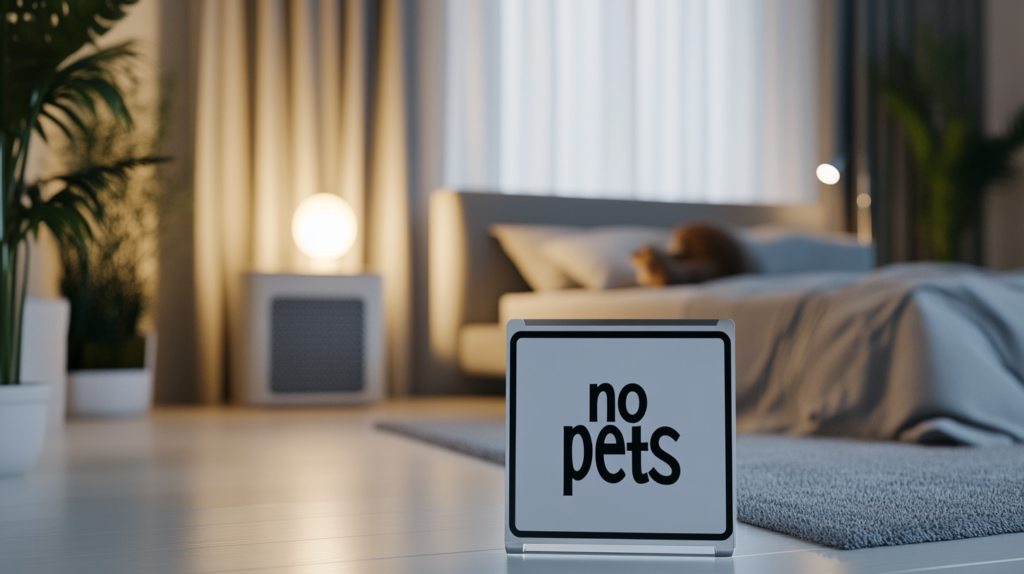
One of the most effective pet allergy reduction techniques is establishing designated allergen-free zones in your home, particularly bedrooms where you spend approximately one-third of your life.
Bedroom Sanctuaries
The bedroom should be your primary allergen-free zone. Consider implementing these measures:
- Keep pets out completely: This may seem difficult initially, but it’s crucial for reducing nighttime symptoms. Install a pet gate if necessary.
- Use allergen-proof covers: Encase mattresses, box springs, and pillows in allergen-proof covers designed to prevent dander from penetrating bedding materials.
- Wash bedding weekly: Use hot water (at least 130°F/54°C) to effectively kill dust mites and remove allergens.
- Remove allergen traps: Minimize carpeting, upholstered furniture, and decorative items that can harbor allergens.
A study published in the Journal of Allergy and Clinical Immunology found that creating an allergen-free bedroom can reduce nighttime symptoms by up to 61% within four weeks.
Additional Allergen-Free Areas
Consider extending your allergen-free strategy to include:
- Home office: If you work from home, maintaining an allergen-free workspace can help you remain productive and comfortable.
- Children’s bedrooms: Particularly important if your child has pet allergies.
- Meditation or relaxation spaces: Areas where deep breathing is practiced should have minimal allergen exposure.
When establishing these zones, consistency is key. Even occasional pet visits can leave behind significant allergen deposits that may take days or weeks to remove completely.
Strategy #2: Implement a Thorough Cleaning Regimen
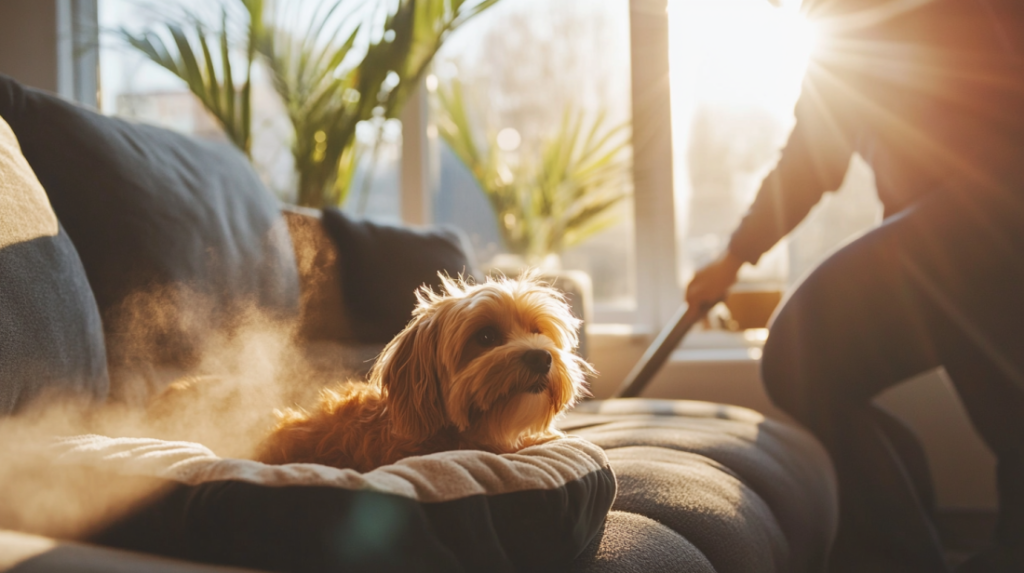
Regular, thorough cleaning is essential for pet allergy reduction. The right cleaning techniques can dramatically reduce the amount of pet allergens in your home environment.
Effective Vacuuming Techniques
- Use a vacuum with a HEPA filter: These filters can trap particles as small as 0.3 microns, including most pet allergens. According to research from the Environmental Protection Agency, HEPA filters can remove up to 99.97% of airborne particles.
- Vacuum all surfaces frequently: This includes carpets, rugs, furniture, and even walls where allergens can settle.
- Focus on hidden areas: Don’t forget to vacuum under furniture, along baseboards, and in corners where pet hair and dander accumulate.
- Consider wearing a mask: This prevents inhalation of allergens stirred up during cleaning.
Beyond Vacuuming: Complete Cleaning Protocol
- Damp dusting: Use microfiber cloths slightly dampened with water or an allergen-reducing solution to capture dander rather than dispersing it into the air.
- Mop hard floors regularly: Wood, tile, and laminate floors should be mopped weekly with an appropriate cleaner.
- Steam cleaning: For carpets and upholstery, deep steam cleaning every 3-6 months can remove embedded allergens.
- Launder pet bedding weekly: Use hot water and allergen-reducing detergent.
Professional Cleaning Considerations
For severe allergies, professional cleaning services that specialize in allergen reduction may be worth the investment. These services typically use commercial-grade equipment and specialized techniques to remove allergens more effectively than standard home cleaning.
Dr. Michael Blaiss, executive medical director of the American College of Allergy, Asthma, and Immunology, recommends: “After getting a professional deep clean, maintain results by implementing a daily quick-clean routine focusing on high-traffic areas and pet lounging spots.”
Strategy #3: Upgrade Your Air Filtration Systems
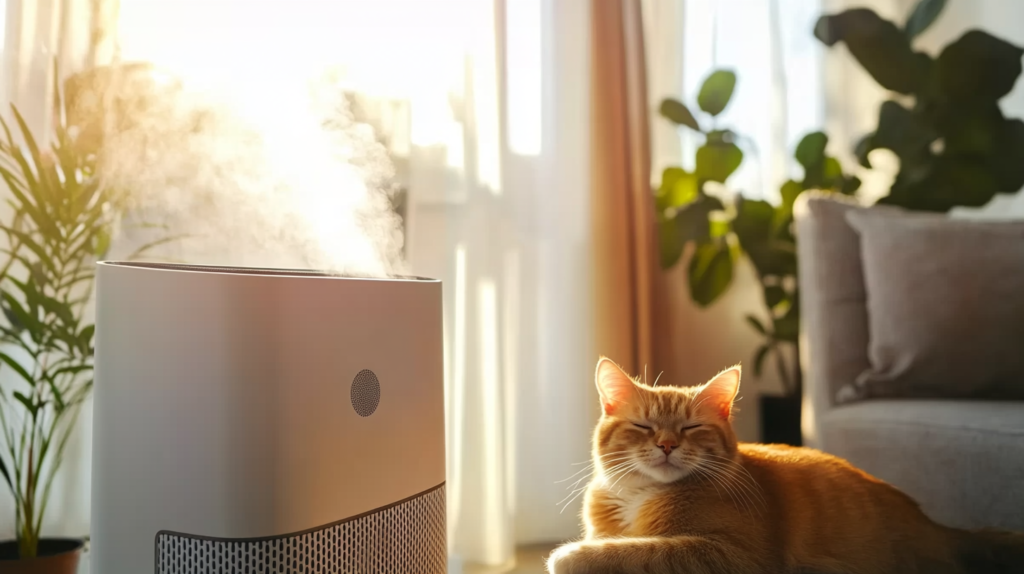
Improving your home’s air quality is a critical component of pet allergy reduction. Since many allergens remain airborne for extended periods, effective air filtration can significantly reduce symptoms.
HEPA Air Purifiers
High-Efficiency Particulate Air (HEPA) purifiers are among the most effective tools for removing pet allergens from the air.
- Placement matters: Position air purifiers in rooms where you and your pets spend the most time.
- Size appropriately: Choose purifiers rated for your room size or slightly larger.
- Maintain filters: Replace or clean filters according to the manufacturer’s recommendations.
A clinical study published in the Annals of Allergy, Asthma & Immunology found that properly sized HEPA air purifiers reduced airborne pet allergens by up to 75% when used consistently.
HVAC System Upgrades
Your central heating and cooling system can either distribute allergens throughout your home or help filter them out.
- Install high-efficiency filters: Use filters with a Minimum Efficiency Reporting Value (MERV) rating of 11-13 for optimal allergen capture.
- Change filters regularly: Replace filters every 1-3 months, or more frequently during high-shedding seasons.
- Consider professional duct cleaning: If you’ve had pets for years without addressing allergens, your ductwork may harbor significant allergen deposits.
Natural Ventilation Strategies
When weather permits, strategic ventilation can help reduce indoor allergen concentrations:
- Cross ventilation: Open windows on opposite sides of the room to create airflow that pushes allergens out.
- Timing matters: Pollen counts are typically lowest in the afternoon and early evening, making these the best times for natural ventilation.
- Consider window filters: Special screens designed to capture allergens can be installed on windows frequently used for ventilation.
Environmental engineer Dr. Sarah Peterson notes: “Many homeowners underestimate the impact of proper ventilation on indoor allergen levels. Even 15-20 minutes of strategic ventilation can significantly reduce airborne allergen concentrations when combined with other pet allergy reduction methods.”
Strategy #4: Regular Pet Grooming and Hygiene
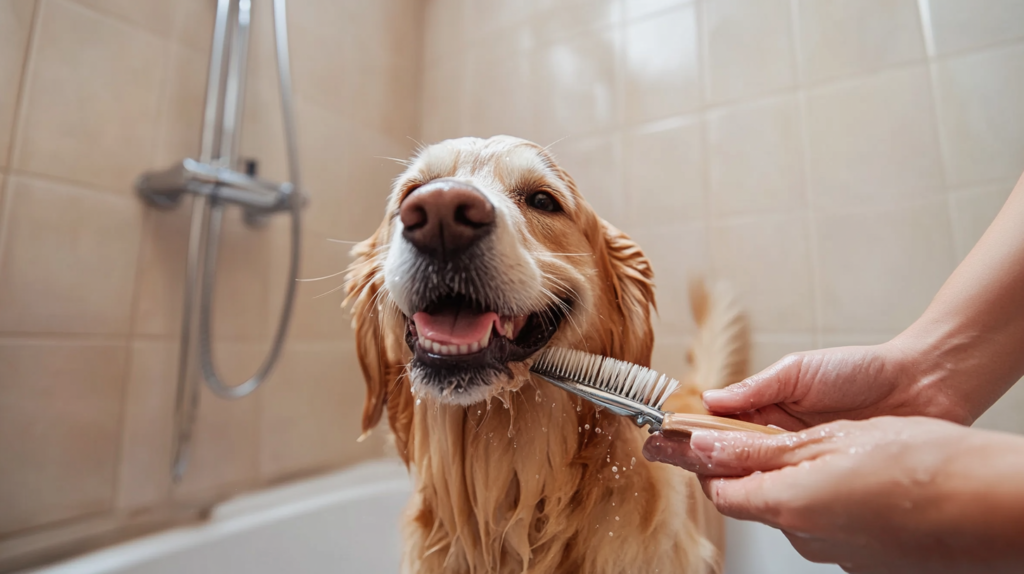
Proper pet grooming is a cornerstone of effective pet allergy reduction. Regular maintenance reduces the amount of allergens your pet releases into your home environment.
Bathing Schedule
- Dogs: Bath your dog every 1-2 weeks using a pet-friendly, allergen-reducing shampoo. More frequent bathing may dry out their skin and actually increase dander production.
- Cats: Though they typically groom themselves, cats can benefit from weekly wipe-downs with pet-friendly allergen-reducing cloths. Some cats tolerate baths every 4-6 weeks.
- Small mammals: Different species have varying bathing needs; consult your veterinarian for specific recommendations.
Research published in the Journal of Veterinary Dermatology found that weekly bathing of dogs reduced measurable allergen levels on their fur by up to 84% for the first three days after bathing.
Brushing Techniques
- Brush outdoors: Whenever possible, brush your pet outside to prevent allergen dispersal indoors.
- Use appropriate tools: Different coat types require different brushing tools for optimal dander and loose fur removal.
- Consistency is key: Daily brushing for 5-10 minutes is more effective than longer, less frequent sessions.
- Consider wearing gloves and a mask: This protects you from direct allergen exposure during grooming.
Professional Grooming Services
For severe allergies or pets that are difficult to groom at home:
- Schedule regular appointments: Professional groomers have specialized equipment and products to reduce dander and allergens.
- Request allergen-reducing treatments: Many professional groomers offer specific services designed to minimize allergen production.
- Time appointments strategically: Schedule grooming appointments before periods when you’ll be spending more time at home, such as weekends or holidays.
Veterinary dermatologist Dr. Karen Campbell explains: “Professional grooming can access deeper layers of the coat and skin that home grooming might miss. This comprehensive approach to pet hygiene can significantly reduce the overall allergen burden in your home.”
Strategy #5: Modify Home Environment and Furnishings
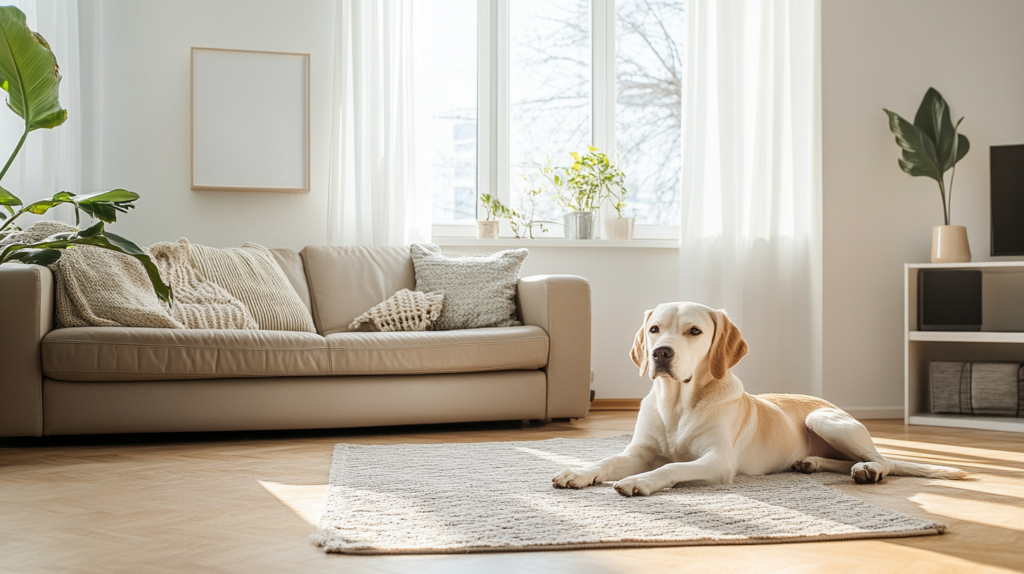
Your home’s interior design and furnishing choices can significantly impact pet allergen levels. Strategic modifications can create an environment that minimizes allergen accumulation and facilitates easier cleaning.
Flooring Considerations
- Replace carpet with hard surfaces: Hardwood, laminate, tile, or vinyl flooring doesn’t trap allergens like carpet does and is much easier to clean thoroughly.
- If carpeting is necessary: Choose low-pile options and steam clean regularly.
- Use washable area rugs: These can be laundered regularly, unlike wall-to-wall carpeting.
A study by the National Institute of Environmental Health Sciences found that homes with hard flooring had up to 50% lower concentrations of pet allergens compared to carpeted homes.
Furniture Selection
- Choose allergen-resistant materials: Leather, vinyl, wood, or metal furniture doesn’t trap allergens like fabric upholstery.
- Use washable slipcovers: If fabric furniture is preferred, invest in machine-washable covers that can be laundered regularly.
- Minimize upholstered items: Reduce the number of upholstered items like decorative pillows, fabric wall hangings, and stuffed toys.
Smart Storage Solutions
- Use closed storage: Cabinets, drawers, and containers with lids keep contents free from settling allergens.
- Store pet items separately: Keep pet toys, bedding, and accessories in designated containers away from allergen-free zones.
- Consider allergen-proof storage bags: Special allergen-blocking bags are available for storing seasonal items like winter clothing or holiday decorations.
Interior designer and certified indoor air quality consultant Jamie Rodriguez recommends: “When redesigning spaces for allergy sufferers, focus on creating environments that are both aesthetically pleasing and easy to maintain. The best allergy-friendly designs incorporate smooth surfaces, minimal textiles, and effective storage solutions that reduce dust and dander accumulation.”
Beyond the Basics: Advanced Pet Allergy Reduction Techniques

For those who need additional allergen control or have particularly severe allergies, these advanced techniques may provide further relief.
Immunotherapy Options
- Allergy shots (subcutaneous immunotherapy): Gradually introduces small amounts of allergens to help your body build tolerance over time.
- Sublingual immunotherapy: Similar to allergy shots but administered as drops or tablets under the tongue.
Dr. Lisa Zhang, immunologist, notes: “Immunotherapy has shown significant success in reducing pet allergy symptoms, with up to 85% of patients experiencing substantial improvement after completing a full course of treatment. However, it requires commitment, as treatment typically spans 3-5 years.”
Pet-Specific Allergen Reducers
- Pet wipes: Special allergen-neutralizing wipes can be used between baths to reduce dander.
- Oral supplements: Some veterinary supplements claim to reduce allergen production in pets, though scientific evidence varies.
- Topical sprays: Products designed to neutralize allergens on your pet’s coat may provide temporary relief.
Technology Solutions
- Allergen-detecting devices: New technologies can measure allergen levels in your home, helping you identify problem areas.
- Automated cleaning systems: Robot vacuums with HEPA filtration can help maintain cleaner floors with minimal effort.
- Smart air quality monitors: These devices can alert you when allergen levels rise, prompting additional filtration or cleaning.
Environmental health specialist Dr. Robert Chen advises: “While these advanced technologies and treatments can be helpful additions to your pet allergy reduction strategy, they work best when combined with the fundamental approaches of cleaning, filtration, and creating allergen-free zones.”
Special Considerations for Different Pets
Each type of pet presents unique allergen challenges and requires specific approaches for optimal pet allergy reduction.
Dogs
- Breed considerations: While no breed is truly hypoallergenic, some produce fewer allergens or shed less dander-carrying fur. These include Poodles, Bichon Frises, and Portuguese Water Dogs.
- Regular ear cleaning: Dog ears can harbor allergens and should be cleaned regularly according to veterinary recommendations.
- Paw wiping routine: Wipe your dog’s paws after walks to prevent outdoor allergens from entering your home.
Cats
- Face and paw focus: Cat allergens concentrate in saliva, which they spread while grooming. Pay special attention to wiping their face and paws.
- Consider allergen-neutralizing food: Some specialty cat foods claim to reduce the production of Fel d 1, the primary cat allergen.
- Litter box management: Cat urine contains allergens, so use dust-free litter and clean boxes frequently in well-ventilated areas.
Small Mammals
- Cage placement: Keep hamsters, guinea pigs, rabbits, and other small pets in well-ventilated areas away from bedrooms.
- Bedding choices: Use low-dust, hypoallergenic bedding materials and change them frequently.
- Enclosed habitats: Consider habitats with good filtration systems that limit allergen escape.
Birds
- Feather dust management: Birds produce a fine powder from their feathers that can trigger allergies. Regular cage cleaning and air filtration are essential.
- Consider air cleaning systems: Specific air purifiers designed for bird owners can help capture feather particles.
- Bathing opportunities: Provide regular bathing opportunities for your bird to reduce dander.
Exotic animal veterinarian Dr. Nina Patel explains: “Each species produces different allergens and requires tailored management strategies. Working with both an allergist and an experienced veterinarian can help you develop the most effective pet allergy reduction plan for your specific situation.”
Balancing Pet Care and Allergy Management
Finding the right balance between caring for your pet and managing allergies is essential for a harmonious household. This requires thoughtful consideration of both human and animal needs.
Communication and Family Involvement
- Establish clear responsibilities: Ensure everyone understands their role in maintaining allergen-reducing practices.
- Create a schedule: Develop and display a cleaning and pet care schedule that distributes tasks appropriately.
- Regular family meetings: Discuss what’s working and what needs adjustment in your allergy management plan.
Monitoring Allergy Symptoms
- Keep an allergy journal: Track symptoms in relation to different pet interactions and environments.
- Regular medical follow-ups: Work with an allergist to adjust medications and strategies as needed.
- Be alert for changes: Sometimes allergies worsen over time with continued exposure, requiring strategy adjustments.
Prioritizing Pet Welfare
- Maintain routine: Pets thrive on consistent care routines, even as you implement allergen-reduction practices.
- Provide ample attention: Ensure allergen concerns don’t reduce the quality time spent with your pet.
- Consider pet comfort: Choose allergen-reduction methods that don’t cause undue stress to your animal companion.
Animal behaviorist and veterinarian Dr. Carlos Mendez emphasizes: “Successful pet allergy management preserves the human-animal bond while reducing symptoms. It’s important to implement changes gradually and monitor your pet’s response to ensure their psychological wellbeing isn’t compromised by new routines or restrictions.”
For more expert pet care tips and product recommendations, visit BlithePet.com — your trusted source for pet wellness.
Conclusion:
Long-Term Success with Pet Allergy Reduction
Living with pet allergies doesn’t mean you have to live without pets. By implementing the five proven strategies outlined in this guide—creating allergen-free zones, thorough cleaning, improved air filtration, regular pet grooming, and environmental modifications—most allergy sufferers can significantly reduce their symptoms while maintaining their cherished bond with animal companions.
Remember that effective pet allergy reduction is a marathon, not a sprint. Consistency in implementing these strategies is more important than perfection. You may need to experiment with different combinations of approaches to find what works best for your specific situation.
Dr. Amanda Rodriguez, allergist and pet owner, offers this encouraging perspective: “In my twenty years of practice, I’ve seen countless patients successfully manage their pet allergies through consistent application of these strategies. The key is persistence and willingness to adjust your approach based on results.”
Have a similar experience with your pet? Share it in the comments below!
Frequently Asked Questions About Pet Allergy Reduction
Are there truly hypoallergenic dog or cat breeds?
No breed is completely hypoallergenic, as all mammals produce some level of dander and allergens. However, some breeds typically produce fewer allergens or shed less fur that carries allergens. For dogs, breeds like Poodles, Bichon Frises, and Schnauzers are often better tolerated by allergy sufferers. For cats, breeds such as Siberian, Balinese, and Devon Rex may cause fewer reactions in some individuals.
How long do pet allergens remain in a home after the pet is gone?
Pet allergens are extremely persistent and can remain in a home for months or even years after a pet is no longer present. Cat allergens are particularly resilient and have been detected in homes up to six years after cats were removed. Complete removal typically requires professional deep cleaning, replacement of soft furnishings, and potentially repainting walls and sealing floors.
Can air purifiers completely eliminate pet allergens?
While high-quality HEPA air purifiers can significantly reduce airborne pet allergens, they cannot completely eliminate them. Air purifiers work best as part of a comprehensive allergen reduction strategy that includes regular cleaning, pet grooming, and environmental modifications. For optimal results, purifiers should run continuously in rooms where you spend the most time.
Is it possible to develop pet allergies suddenly after years of pet ownership?
Yes, it’s entirely possible to develop allergies to pets after years of exposure without previous symptoms. The immune system can become sensitized to allergens over time, eventually reaching a threshold where allergic reactions begin to occur. This is why some people experience the sudden onset of allergies despite having lived with pets for many years without problems.
Can children outgrow pet allergies?
Some children do outgrow pet allergies as their immune systems mature, but many carry these allergies into adulthood. Research suggests that approximately 20-30% of children with pet allergies will see their symptoms improve or resolve by adulthood. Early exposure to pets may actually reduce the likelihood of developing allergies in some children, though this depends on genetic factors and individual predisposition.
How effective are allergy medications for managing pet allergies?
Allergy medications can be quite effective at managing symptoms but don’t address the underlying cause—the presence of allergens. Antihistamines, nasal corticosteroids, leukotriene modifiers, and other medications can provide relief from symptoms like sneezing, itching, and congestion. However, they work best when combined with environmental allergen reduction strategies rather than relied upon as the sole solution.

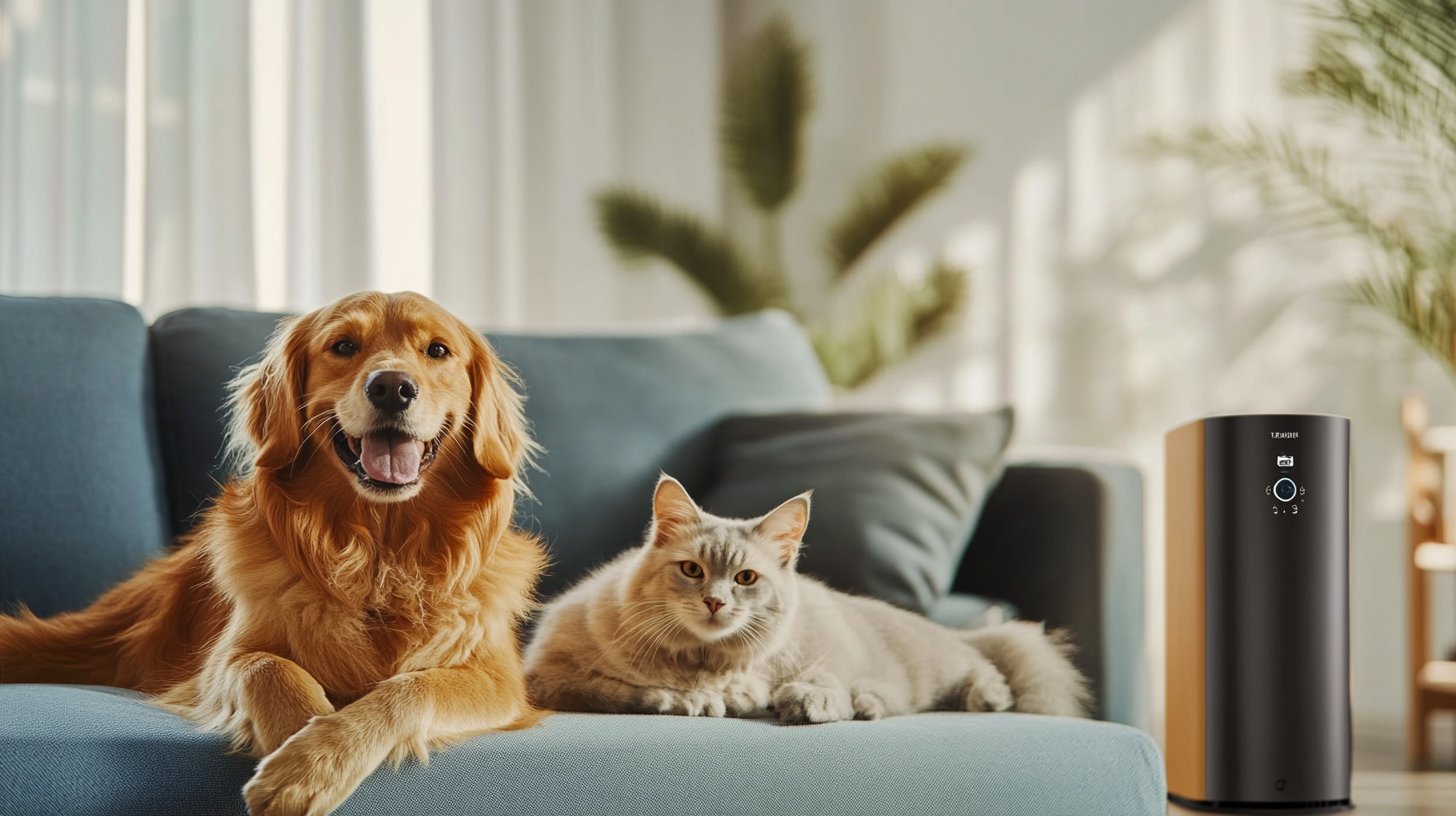






Leave a Reply